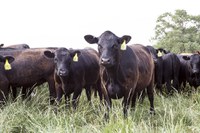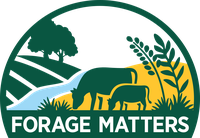Forage Matters: About time
(Click an image below to view a high-resolution image that can be downloaded)
Time is something that we never seem to have enough of. I know that I sure don’t. I am reaching the age where I look back and wonder, “Where did that decade go? Did I misplace it somewhere?”
Time is also an asset. I love having the time to think through a project completely, including what I need, what could go wrong and the outcome if everything goes right.
All time is valuable; in production agriculture, time is especially precious. In grazing management, there are at least three concepts of time: start time, when grazing begins; time of duration, how long the grazing event is maintained; and time off, for rest and recovery. Each time is important to achieve animal production goals and to maintain the persistence and productivity of the grazing resource. The application of time will depend on the environment in which you are working and the plants and animals with which you are working.
Start time is dependent on the environment, the pasture or range species and the past grazing management. In northern climates, it takes some time for soil temperatures, as well as daytime and nighttime temperatures, to reach a point where grazing plants break dormancy and spring growth can begin. Once pastures and range begin to turn green, cattle may be ready to graze, but are the pasture areas ready to be grazed?
Start time, or turn-out time, can be tricky to judge. It is a balancing act between the growth and development of the plant (i.e., the number of leaves it has produced), the plant's growth rate, the total amount of forage mass available for grazing and the animal demand. To add another layer to this, there is a notable difference between cool-season grasses and warm-season grasses that are ready to be grazed. To complicate things even further is considering how the pasture was managed the year before, as well as the environmental conditions it was subjected to (drought, heat, wet, cold).
A concept called grazing readiness can help determine when grasses are ready for grazing (start time). Grazing readiness accounts for the plant’s leaf development and its ability to withstand grazing. To do this, you must be familiar enough with grass identification to be able to distinguish between introduced grasses and native grasses.
In general, the start time for introduced grasses is the three-leaf stage, and for native grasses, it is the 3 ½-leaf stage. At this point, the plant's photosynthetic leaf engine has developed sufficiently to sustain plant growth without relying on stored energy reserves. When the plant reaches this growth stage depends on spring weather conditions and grazing management practices implemented in the previous fall. If plants are grazed to the point that adequate energy reserves for spring growth are not developed in the fall, this will delay spring growth and development. Grazing start time depends on the plant's development, not a calendar date.
If plants have reached the grazing readiness stage, does that mean they are ready for grazing? That depends on the volume or forage mass available. Spring daily forage growth can be rapid; however, if growth cannot keep pace with animal demand, plants can become overgrazed. This leads to the question of duration: how long do you allow animals to graze? This is where the art of grazing management comes into play.
We know from years of data collected from grazing trials how grazing too closely too often affects a grazing system. Cattle are highly selective grazers if they are allowed. They consistently select for quality. They seek out the high-quality plants and plant parts and will graze them to oblivion if allowed. The art of the grazing manager is to know both the plants and animals well and to artfully graze in a way that preserves the forage resource while meeting animal production and management goals.
Finally, there is time off. I really enjoy my time off. It's time for me to get some rest and enjoy doing whatever I want. The plants that make up our pasture and range also enjoy rest. I was told a long time ago that allowing a rest period for a pasture or range is “active management,” and it is.
Again, the art of grazing management plays a crucial role in determining the length of a rest or recovery period. Time or duration of grazing recovery is not a calendar time period. It is based on the plant species, as well as the intensity and duration of the grazing event. Not all plants are designed the same way, and because of the location of their growth points, some can recover much quicker from grazing than others. Was the length of the grazing so long that the same plants were grazed multiple times? If so, this area may need extra recovery time. Be cautious, as plants that were left ungrazed will likely remain ungrazed when cattle return. This can become a problem over time and may require an increase in stock density to reset the area and return it to an even competitive level. Again, the time of rest and recovery is not a calendar period; it is based on the plant's recovery.
Enjoy your time; the holidays are fast approaching. Make sure you share it with family and friends. I know I will.
(James Rogers is a North Dakota State University Extension forage crops production specialist at the North Central Research Extension Center near Minot, North Dakota.)
NDSU Agriculture Communication – Nov. 20, 2025
Source: James Rogers, 701-857-7682, james.rogers.1@ndsu.edu
Editor: Dominic Erickson, 701-231-5546, dominic.erickson@ndsu.edu




